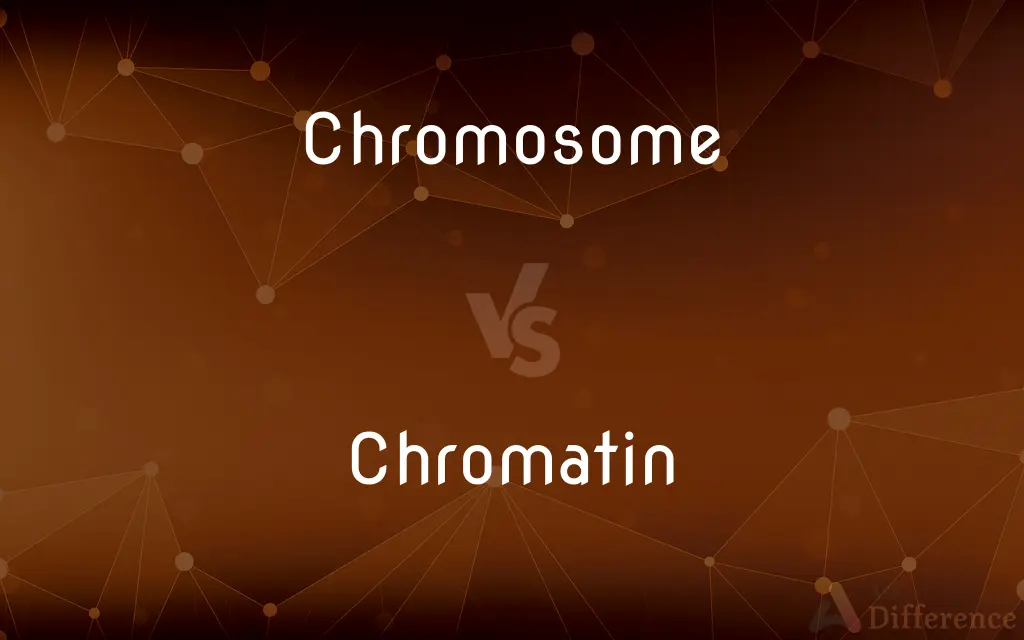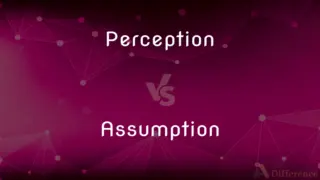Chromosome vs. Chromatin — What's the Difference?
By Tayyaba Rehman & Urooj Arif — Updated on March 11, 2024
Chromosomes are structured DNA strands vital for genetic inheritance, while chromatin is DNA wrapped around proteins, facilitating compaction and organization.

Difference Between Chromosome and Chromatin
Table of Contents
ADVERTISEMENT
Key Differences
Chromosomes are distinct structures composed of DNA and proteins that become visible in a cell's nucleus during cell division. They carry genetic information crucial for inheritance and organism development. Chromatin, on the other hand, is the complex of DNA and proteins, primarily histones, that makes up chromosomes, existing within the nucleus to package and protect the DNA.
While chromosomes are observable and countable during the metaphase of cell division as individual entities, chromatin is present throughout the cell cycle, dynamically changing its structure to regulate gene expression and DNA replication. Chromosomes serve as carriers of genes and are key in the process of cell division, ensuring accurate distribution of genetic material to daughter cells.
Chromatin's role extends beyond mere packaging; it regulates DNA accessibility, thereby controlling gene expression and DNA replication. Chromosomes, structured through chromatin compaction, facilitate the efficient segregation of genetic material during cell division. This structural organization is crucial for maintaining genomic integrity and function.
The physical state of these two entities differs significantly; chromatin's form varies from less condensed euchromatin, active in transcription, to highly condensed heterochromatin, which is transcriptionally inactive. Chromosomes, however, are highly condensed structures visible only during cell division, representing the most compacted form of chromatin.
Comparison Chart
Definition
Structured DNA strands vital for genetic inheritance
DNA wrapped around proteins, facilitating compaction and organization
ADVERTISEMENT
Visibility
Visible during cell division
Present throughout the cell cycle, not visible as distinct entities
Composition
DNA and proteins, including histones
DNA and proteins, primarily histones
Function
Carry genes and ensure accurate genetic material distribution during cell division
Package DNA, regulate gene expression and DNA replication
Physical State
Highly condensed and countable structures during metaphase
Varies from less condensed (euchromatin) to highly condensed (heterochromatin)
Compare with Definitions
Chromosome
Carries genetic information.
Each chromosome contains hundreds to thousands of genes.
Chromatin
Compacts DNA into the nucleus.
Chromatin allows the meter-long human DNA to fit into the microscopic nucleus.
Chromosome
Ensures genetic distribution.
During mitosis, chromosomes are duplicated and distributed evenly to daughter cells.
Chromatin
Controls access to genetic information.
Chromatin structure modifications can activate or silence genes.
Chromosome
Visible during metaphase.
Human cells typically have 46 chromosomes visible under a microscope during cell division.
Chromatin
Changes form based on cellular needs.
Chromatin becomes more condensed during cell division.
Chromosome
Number and appearance of chromosomes in a cell.
A karyotype analysis can reveal chromosomal abnormalities.
Chromatin
Less condensed, associated with active transcription.
Genes in euchromatin regions are often actively expressed.
Chromosome
Chromosomes with corresponding genetic information.
In diploid organisms, chromosomes exist in homologous pairs, one from each parent.
Chromatin
Highly condensed, transcriptionally inactive.
Heterochromatin contains regions of DNA that are rarely transcribed.
Chromosome
A chromosome is a long DNA molecule with part or all of the genetic material of an organism. Most eukaryotic chromosomes include packaging proteins called histones which, aided by chaperone proteins, bind to and condense the DNA molecule to maintain its integrity.
Chromatin
Chromatin is a complex of DNA, protein and RNA found in eukaryotic cells. Its primary function is packaging long DNA molecules into more compact, denser structures.
Chromosome
A linear strand of DNA and associated proteins in the nucleus of eukaryotic cells that carries the genes and functions in the transmission of hereditary information.
Chromatin
A complex of nucleic acids and proteins, primarily histones, in the cell nucleus that stains readily with basic dyes and condenses to form chromosomes during cell division.
Chromosome
A circular strand of DNA in bacteria and archaea that contains the hereditary information necessary for cell life.
Chromatin
(biology) A complex of DNA, RNA and proteins within the cell nucleus out of which chromosomes condense during cell division.
Chromosome
A linear arrangement of condensed DNA and associated proteins (such as chaperone proteins) which contains the genetic material (genome) of an organism.
Chromosomes store genetic information.
Chromatin
Tissue which is capable of being stained by dyes.
Chromosome
One of the minute bodies into which the chromatin of the nucleus is resolved during mitotic cell division; the idant of Weismann.
Chromatin
The deeply staining substance of the nucleus and chromosomes of eukaryotic cells, composed of DNA and basic proteins (such as histones), the DNA of which comprises the predominant physical basis of inheritance. It was, at the beginning of the 20th century, supposed to be the same substance as was then termed idioplasm or germ plasm. In most eukaryotic cells, there is also DNA in certain plasmids, such as mitochondria, or (in plant cells) chloroplasts; but with the exception of these cytoplasmic genetic factors, the nuclear DNA of the chromatin is believed to contain all the genetic information required to code for the development of an adult organism. In the interphase nucleus the chromosomes are dispersed, but during cell division or meiosis they are condensed into the individually recognizable chromosomes. The set of chromosomes, or a photographic representation of the full set of chromosomes of a cell (often ordered for presentation) is called a karyotype.
Chromosome
A threadlike body in the cell nucleus that carries the genes in a linear order
Chromatin
The readily stainable substance of a cell nucleus consisting of DNA and RNA and various proteins; during mitotic division the chromatin condenses into chromosomes
Common Curiosities
What determines the number of chromosomes in an organism?
The number of chromosomes is species-specific and determined by evolutionary processes, not directly related to organism complexity.
What happens to chromosomes during cell division?
Chromosomes replicate, condense, and are then segregated into daughter cells to ensure each cell receives a complete set of genetic information.
Are all parts of a chromosome equally active in gene expression?
No, gene expression varies across a chromosome, depending on chromatin structure and gene location.
Can chromatin exist outside of chromosomes?
No, chromatin is the material that makes up chromosomes; it does not exist independently but forms chromosomes.
How do changes in chromatin structure affect a cell?
Changes in chromatin structure can affect gene expression patterns, impacting cell function, differentiation, and response to environmental cues.
Can chromatin be modified?
Yes, chromatin undergoes various chemical modifications that can alter its structure and function, influencing gene expression.
What role do histones play in chromosomes?
Histones are proteins around which DNA winds to form chromatin, playing a key role in chromosome structure and function.
How does chromatin affect gene expression?
Chromatin structure influences gene expression by controlling the accessibility of DNA to transcription machinery.
What is the significance of chromosome numbers in genetic disorders?
Abnormalities in chromosome number or structure can lead to genetic disorders due to the disruption of gene dosage and expression.
How is chromatin studied in the lab?
Chromatin is studied using techniques like chromatin immunoprecipitation (ChIP), microscopy, and next-generation sequencing to understand its structure and function in gene regulation.
Share Your Discovery

Previous Comparison
Inscriptionist vs. Inscription
Next Comparison
Perception vs. AssumptionAuthor Spotlight
Written by
Tayyaba RehmanTayyaba Rehman is a distinguished writer, currently serving as a primary contributor to askdifference.com. As a researcher in semantics and etymology, Tayyaba's passion for the complexity of languages and their distinctions has found a perfect home on the platform. Tayyaba delves into the intricacies of language, distinguishing between commonly confused words and phrases, thereby providing clarity for readers worldwide.
Co-written by
Urooj ArifUrooj is a skilled content writer at Ask Difference, known for her exceptional ability to simplify complex topics into engaging and informative content. With a passion for research and a flair for clear, concise writing, she consistently delivers articles that resonate with our diverse audience.















































